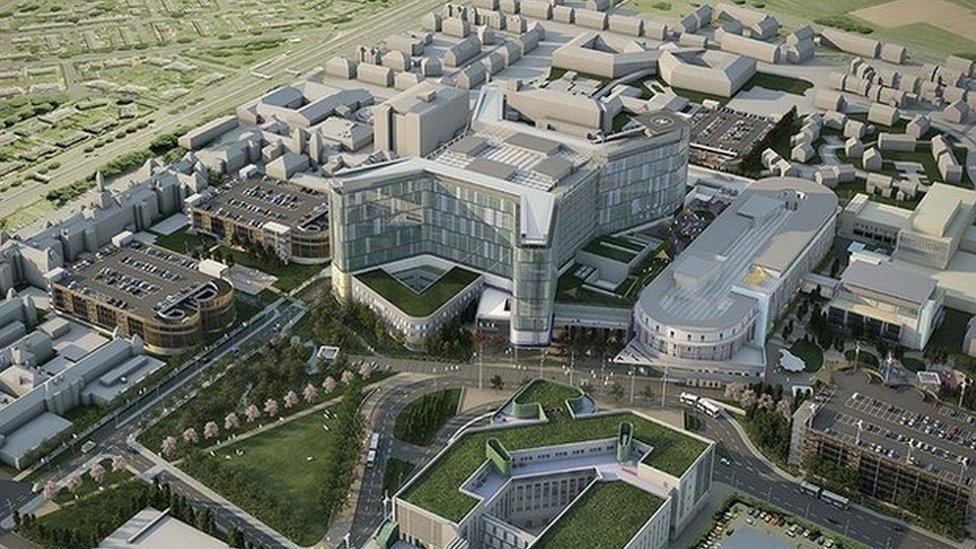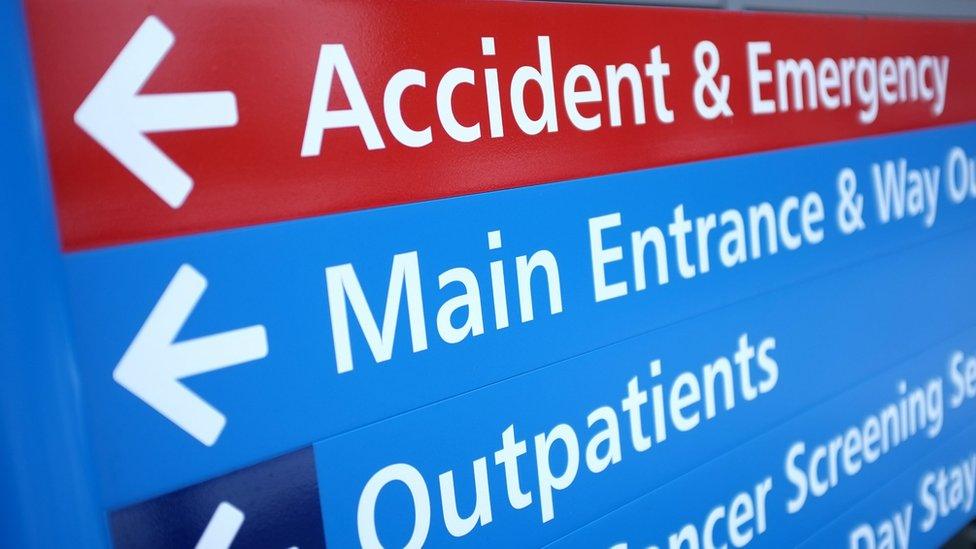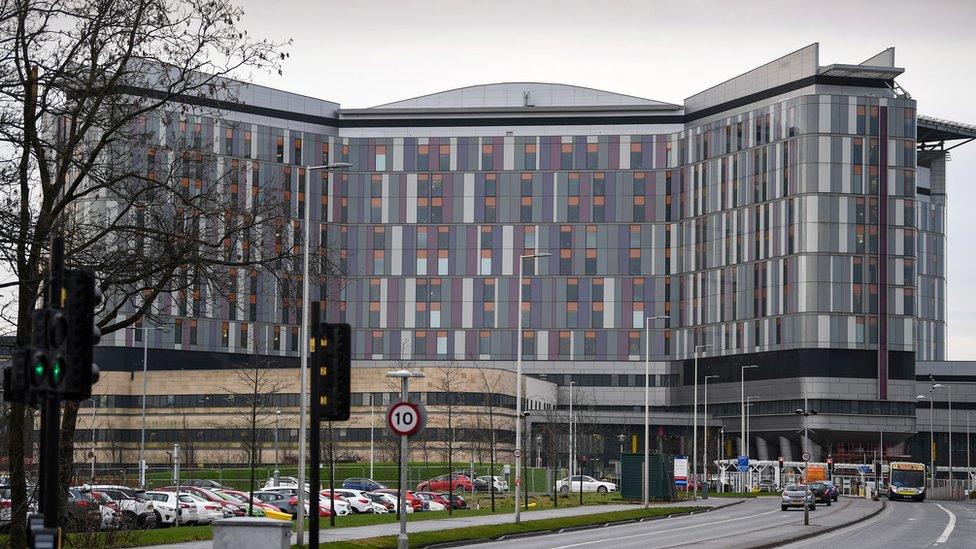Timeline: The trials of the Queen Elizabeth University Hospital complex
- Published

The £842m Queen Elizabeth University Hospital began taking patients in April 2015
When it opened in 2015, Scotland's "super hospital" was hailed as one of the world's most advanced healthcare facilities. But since then the £842m Glasgow complex - made up of the Queen Elizabeth University Hospital (QEUH) and the Royal Hospital for Children (RHC) - has often made headlines for the wrong reasons.

2015
27 April: The QEUH, nicknamed the "Death Star" due to its imposing 14-storey star-shaped design, opened its doors to patients.
26 May: Claims emerged that the new hospital was in chaos after just four weeks. One woman told the BBC it was like "a war zone" over the bank holiday weekend and her terminally-ill husband had to wait eight hours to be admitted. NHS Greater Glasgow and Clyde (NHS GGC) apologised, and said it was undertaking the UK's largest hospital migration.
16 June: It was announced government trouble-shooters were being sent to the hospital to help improve A&E waiting times. Figures showed the QEUH was the worst-performing in Scotland for patient waiting times. The Scottish government's target is for 95% to be seen and subsequently admitted, transferred or discharged within four hours, but just 78.3% of patients were dealt with within the target window.
3 July: The Queen officially opened the hospitals and the Queen Elizabeth Teaching and Learning Centre. The 1,667-bed facility, which was built on the site of Southern General, incorporates two A&E departments - one for adults and one for children - a maternity hospital and state-of-the-art laboratory services.
20 October: A&E waiting times were found to be below all other casualty units. Just 82.9% of patients at the QEUH were dealt with within four hours. This was an improvement on the previous week's figure of 77.2%, a record low for the hospital.
3 November: A baby died in a maternity unit linked to the new RHC after becoming infected with harmful bacteria. The baby, who contracted Serratia marcescens, was premature and had "existing complex medical problems". The bacteria were also present in five other babies in the maternity unit, and seven who had left hospital. However, none gave cause for concern.
6 November: An investigation was launched after an elderly man died on a trolley at the £842m hospital following a six-hour wait for treatment. The Daily Record, external said the patient suffered cardiac arrest in a corridor at the Immediate Assessment Unit of the QEUH. NHS GGC said a review of the patient's treatment would be carried out. It said the assessment unit had been "under pressure" when the man attended.
18 November: The hospital's Immediate Assessment Unit had to be expanded because it was too small to cope with demand. It handles patients referred by a doctor. NHS GGC said it had been "seeing significantly more patients than was projected".
2016
20 December: The hospital recorded its worst A&E waiting times. Just under 76% of A&E patients at the QEUH in Glasgow were treated within four hours in the week ending 11 December. The target is 95%. Ministers said an increase in demand had affected waiting times.
2017
29 March: Patient equipment contaminated by blood and faeces was found during an inspection of the QEUH. The Healthcare Environment Inspectorate raised "significant concerns" after unannounced visits to the hospital. Inspectors also found dust and body fluids on patient trolleys and mattresses.
24 April: An NHS director apologised to patients who had experienced problems at the QEUH, which consistently had some of the poorest waiting time figures for A&E in Scotland. Concerns were also raised about workload pressures and the number of operations cancelled because of a shortage of beds. Dr Jennifer Armstrong acknowledged the problems were "unacceptable" but said the hospital was performing some of the most advanced medical treatments in the world.
10 August: NHS GGC announced cladding similar to that used on Grenfell Tower was to be removed from the QEUH and the RHC. The health board said "forensic checks" had identified material similar to, but not the same as, that used on the London building which was devastated by a fire that claimed 72 lives. The board said the cladding would be removed as a "precautionary measure".
2018
4 January: The health board apologised to patients for lengthy waits at hospital A&E departments over the festive period. The QEUH had to cancel 14 operations on a single day due to winter pressures from flu, respiratory infections and norovirus.
12 February: NHS GGC confirmed taxpayers would foot the £6m bill for replacing cladding panels on the two new hospitals. The Scottish government funded the work.
16 March: It emerged three children were being treated for infections that may be linked to bacteria in the water supply. NHS GGC launched an investigation after the microorganisms were discovered at the RHC. Health officials said the bacteria could pose harm to patients with "compromised" immunity.
5 June: Bacteria was found on two wards at the RHC during drain testing. The board announced patients would be temporarily moved to another room until work is completed.
9 August: An investigation was launched after a panel fell from the 10th floor of the QEUH. It was understood it shattered near the front entrance but no-one was injured.
28 August: Safety netting was erected around the hospital in response to the panel incident. The health board said an investigation proved inconclusive. Reports claimed panels have fallen from the building on at least three occasions since it opened.
18 September: Child cancer patients at the RHC were moved from two wards due to problems with the water supply. For the first six months of the year a number of patients in wards 2A and 2B were affected by bacteraemia. NHS GGC said extensive work was carried out on the taps in the wards. But then six new cases were reported and an incident management team was appointed.
21 November: It was announced the RHC was to be without running water following a bacteria scare. NHS GGC said the supply would be shut off on 22 November between midnight and 04:00. A second shutdown to allow chlorine dioxide dosing took place for the same period on 29 November. Patients were offered commodes, portable toilets, hand gel and bottled water.
6 December: The RHC said work to resolve problems with bacteria in the water in two cancer wards had been completed. Four child cancer patients were moved to an adult ward in the adjoining QEUH when the problems were discovered. The other 18 patients from ward 2A and the outpatients who attended ward 2B were switched to another ward in the QEUH. It followed several new cases of patients being affected by bacteraemia.
2019
19 January: The health board revealed that two patients died after contracting Cryptococcus, a fungal infection caused by pigeon droppings at the QEUH. The patients were later revealed to be a 10-year-old boy (who died in December) and a 73-year-old woman (who died in January). A non-public room, thought to contain machinery, was identified as a likely source.
20 January: A former health secretary called for an inquiry into the patients' deaths. Alex Neil's comments came as it emerged the problem at the QEUH was reported in December.
22 January: It was confirmed the Cryptococcus infection was a "contributing factor" in the death of the 10-year-old at the Glasgow hospital. Health Secretary Jeane Freeman ordered a review of the design of the QEUH and the hospital put infection control measures in place. Despite the scare, officials insisted the hospital is safe for patients and visitors.
25 January: It was announced prosecutors were investigating the 10-year-old patient's death.
27 January: A patient at the QEUH was reported to be seriously ill after contracting a fungal infection. Ms Freeman said the patient was one of two affected by the infection, related to Mucor mould. The health secretary ordered a review to investigate how the building's design, handover and maintenance contributed to effective infection control.
29 January: It emerged prosecutors were now also investigating the death of a 73-year-old patient who died at the QEUH after contracting Cryptococcus.
12 February: A Holyrood committee is to examine hospital safety following the deaths of the two patients.
22 February: An investigation into the water supply at the QEUH found "widespread contamination". The probe was launched after an infection outbreak in two cancer wards at the neighbouring RHC the previous year. A report by Health Protection Scotland says contamination was found in taps and drains at both hospitals. It said work to fix the problem was ongoing. A total of 23 children contracted bloodstream infections in the cancer wards between January and September 2018.
8 March: A report found some areas of Scotland's biggest hospital cannot be cleaned properly because they are awaiting repair work. The inspection was ordered after patients became infected with a fungus linked to pigeon faeces. The report found 300 repair jobs were waiting to be done, but there was no evidence of a plan to complete them. It also said the emergency department had not been properly cleaned.
14 March: It was announced prosecutors are investigating the death of a third patient at the hospital. Mito Kaur, 63, was one of two patients affected by a fungal infection, Mucor. Ms Kaur was admitted to the hospital on 7 January and died a day before her 64th birthday. The Crown Office confirmed it was aware of the death of Ms Kaur and had instructed Police Scotland to carry out inquiries. However, the Crown has since concluded that Mucor was not a contributory factor in Ms Kaur's death.
19 March: Communication between infection control nurses and maintenance staff at the hospital was "not particularly great", according to Healthcare Improvement Scotland. MSPs were also told a "backlog" of repairs had built up and that there were issues with communication about the work.
4 August: A ward was closed to new admissions at the QEUH after three young patients contracted infections. Children had been moved there from the neighbouring RHC. Work is being carried out on its water supply and air quality systems. NHS GGC said, however, there was "nothing to link the infections" to practices or the environment of the QEUH ward. Outpatients and day cases are being dealt with as normal. The decision to halt admissions was taken after the two most recent infection cases were detected.
17 September: A public inquiry will be held to examine safety and wellbeing issues at the new children's hospital in Edinburgh and the QEUH. The inquiry will determine how vital issues relating to ventilation and other key building systems occurred. It will also look at how to avoid mistakes in future projects.
14 November: The health secretary says she knew in September a child had died after contracting an infection in a cancer ward in 2017, possibly linked to water, but did not make it public. She told BBC Scotland she acted on the information but chose to maintain patient confidentiality. Labour MSP Anas Sarwar described the situation as a "cover-up".
15 November: The mother of a 10-year-old girl who died at the RHC claims she was "let down and lied to" by health officials. Milly Main contracted an infection in 2017 while recovering from leukaemia. Her mother Kimberley Darroch told the BBC she was "100%" certain contaminated water caused the fatal infection. NHS GGC insisted the source of the infection cannot be determined.
17 November: It emerged a three-year-old boy's death in the RHC has been investigated by police. The Crown Office confirmed the child died on 9 August 2017. NHS GGC said they had fully investigated and shared their findings with the boy's family.
18 November: Scotland's health secretary refused to rule out government intervention at the under-fire health board. The health board later said it was "truly sorry" for the distress caused to parents following the deaths of two children.
19 November: Ms Freeman told Holyrood's health and sport committee an independent review examining water contamination and other problems at the hospital will be published in spring 2020.
22 November: Glasgow's health board was placed in "special measures". Health Secretary Jeane Freeman said NHS Greater Glasgow and Clyde would be escalated to stage four of the NHS Board Performance Escalation Framework.
28 November: A report was leaked which showed that days after the hospital opened in 2015 warnings were given about the risk of water contamination. The report, which was passed to Labour MSP Anas Sarwar by whistleblowers, ranked infection control measures as "high risk" in several areas. Despite the warnings, the hospital stayed open but has since had to close wards due to the risks from the water. The board insisted the hospital campus has a "safe and effective water supply" and all inspection reports were acted upon.
1 December: The Herald newspaper reported, external that another investigation was under way after another child, who died in November, was found to have a hospital-acquired infection. But the board's chief executive reassured parents that the hospital was safe and that infection rates were in line with other paediatric units.
10 December: The government appointed Professor Marion Bain to oversee infection prevention and control at the QEUH. Prof Bain is a former medical director at NHS National Services Scotland. The health secretary said she hopes bringing in external experts would help secure patient confidence, while an independent inquiry would answer questions about the building's design.
17 December: The health board instructed legal action against the hospitals' contractor, Brookfield Multiplex. The company was responsible for the design and construction of the £575m complex. The board's chief executive apologised to to patients for the "distress" caused by the issues the hospitals have faced, adding that the board was "determined to resolve" the problems.
- Published31 January 2019

- Published22 January 2019
